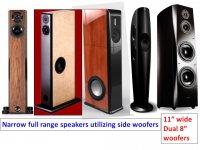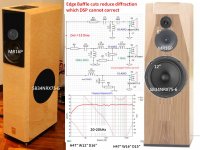Can you make a good 4 way speaker by using an 80Hz low pass filter in parallel with a 3 way cross over (to feed a sub-woofer)?
I was thinking as long as the woofer was selected to avoid overlap with the sub-woofer (below 80Hz) this was an OK approach.
Is this a bad idea and if so what are the concerns?
I was thinking as long as the woofer was selected to avoid overlap with the sub-woofer (below 80Hz) this was an OK approach.
Is this a bad idea and if so what are the concerns?
About 35 years ago I've assembled a speaker kit with French drivers, called Focal Onyx, which indeed implemented this idea. We might call it 3½ way 😉.
Best regards!
Best regards!
Is this a bad idea and if so what are the concerns?
Could you provide more information on the rest of the drivers, enclosure, what specific crossover parts values, etc?
more details
12" sub woofer, 5" mid range, 1" soft dome.
I have yet to buy the woofer but I'm looking at an 8" with an enclosed F3 87Hz, and wondering if a smaller woofer would work better.
The crossover is 1000 and 6000, if memory serves (I won't know for sure until I open some old cabinets).
12" sub woofer, 5" mid range, 1" soft dome.
I have yet to buy the woofer but I'm looking at an 8" with an enclosed F3 87Hz, and wondering if a smaller woofer would work better.
The crossover is 1000 and 6000, if memory serves (I won't know for sure until I open some old cabinets).
OK I'll proceed with the 3.5 design
Thanks Kay, since no one is saying this is a bad idea I'll move forward with a "3.5 way" speaker design.
Thanks for your reply, -Jay
Thanks Kay, since no one is saying this is a bad idea I'll move forward with a "3.5 way" speaker design.
Thanks for your reply, -Jay
Can you make a good 4 way speaker by using an 80Hz low pass filter in parallel with a 3 way cross over (to feed a sub-woofer)?
I was thinking as long as the woofer was selected to avoid overlap with the sub-woofer (below 80Hz) this was an OK approach.
Is this a bad idea and if so what are the concerns?
I think you mean high pass filter - in that the frequencies below 80Hz are filtered out?
If so, to do this passively will require large component values on the woofer = expensive.
I'd recommend a sealed enclosure (since you are not after bass extension) to raise F3. A Qtc ~ 0.7 will steepen the dropoff. a target f3 of 80Hz isn't really required for effective subwoofer blending assuming your sub has a variable XO lowpass frequency. You'll find room modes probably swamp the ideal "flat" response. Speaker and sub placement in room, sub phase, sub XO point and sub SPL level can be used to resolve most of these issues.
PS: You want overlap between your sub and mains. sub XOs aren't cliffs - usually 12dB electrical rolloff.
No, I meant low pass filter (as in frequencies above 80 Hz roll off at 12db).
That would feed the 12" driver making it a subwoofer that does not overlap with the other drivers, which are to be powered from a 3 way crossover in parallel.
During testing (initial listening) if I find the the subwoofer is not well matched to other drivers in volume I was going to add an L-pad attenuator.
Since I just made up this approach myself as a way to use components I already have in the space I have, and I am not experienced with cross over design, I was checking in here to be sure this approach can work and it does not have a serious problem.
Since another member said they had done this before I'm thinking its an OK approach.
That would feed the 12" driver making it a subwoofer that does not overlap with the other drivers, which are to be powered from a 3 way crossover in parallel.
During testing (initial listening) if I find the the subwoofer is not well matched to other drivers in volume I was going to add an L-pad attenuator.
Since I just made up this approach myself as a way to use components I already have in the space I have, and I am not experienced with cross over design, I was checking in here to be sure this approach can work and it does not have a serious problem.
Since another member said they had done this before I'm thinking its an OK approach.
Speakers with two 8" woofers are very common because they allow a narrow 10"-11" wide front baffle, and provide the same area as a 12" woofer. You can even mount the two woofers side-to-side near the bottom of the cabinet if you want a 7" wide front baffle for your 5" midrange. Audio Physic Inc... championed this narrow front baffle.
There are a few 12" woofers like the SB_Acoustics SB34NRX75-6 which produce deep 32Hz bass in a tight transient SEALED 3+cuft cabinet. The 12" can be mounted on a wide side baffle, and the cabinet can be tall to get 3+ cuft volume.
There are a few 12" woofers like the SB_Acoustics SB34NRX75-6 which produce deep 32Hz bass in a tight transient SEALED 3+cuft cabinet. The 12" can be mounted on a wide side baffle, and the cabinet can be tall to get 3+ cuft volume.
Attachments
An "overlap" creates at worse a 3dB bump, which is unlikely to be your worse deviation from "flat" response.
- Status
- Not open for further replies.
- Home
- Loudspeakers
- Multi-Way
- 4-way cross-over design question

